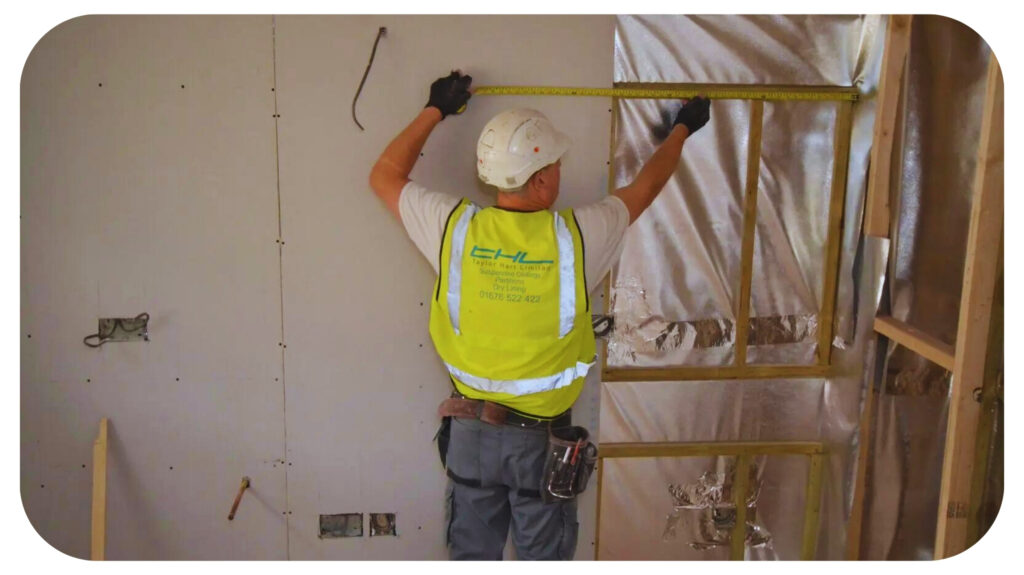Deciding On Drylining Yourself Or Hiring A Professional

When it comes to home renovation projects, drylining is often a job that requires doing to complete them.
Whether you are looking to spruce up a room or undertake a larger renovation, the decision to tackle drylining yourself or hire a professional is significant. Drylining, the process of attaching plasterboard to walls or ceilings, can seem straightforward at first glance, but there are various factors to consider before deciding.
Below, we will delve into the pros and cons of both options to help you make an informed choice and decide which is best for you.
DIY Drylining
For the avid DIY enthusiast, taking on drylining projects can be enticing and a cost-effective way to complete a project rather than hiring a professional. Here are some advantages:
- Cost Savings: One of the most appealing aspects of DIY drylining is the potential cost savings. You can avoid labour costs associated with hiring a professional tradesperson by doing the work yourself.
- Sense of Achievement: Completing a drylining project alone can be incredibly rewarding. There is a satisfaction that comes with seeing a space transform and knowing you did it yourself.
- Flexibility: When you DIY, you have full control over the project timeline and can work at your own pace. You can also tailor the project to your specific preferences without consulting with a contractor.
However, DIY drylining also comes with its fair share of challenges:
- Skill Level: Drylining requires a certain level of skill and precision. If you have no experience with this type of work, you may encounter difficulties achieving a professional finish.
- Time-Consuming: While DIY projects offer flexibility, they can also be time-consuming. Drylining can be particularly labour-intensive, especially if you work alone or have limited experience.
- Potential Mistakes: Without proper knowledge and expertise, there’s a risk of making mistakes that could compromise the integrity of the finished product. These mistakes may require costly repairs or rework down the line.
If you have the confidence and time available, drylining your project yourself can be a highly rewarding experience and give you the confidence to tackle bigger projects in future. However, you must avoid attempting the job, messing it up, and paying a professional to repair the damage, which could cost more in the long run.
Hiring a Professional:
Hiring a professional tradesperson is often the preferred option for those who prefer to leave drylining to the experts. Paying a skilled and qualified craftsperson can give you peace of mind, and here are some advantages:
- Expertise: Professional drylining experts have the necessary skills, drylining supplies, and experience to ensure a high-quality finish. They understand the intricacies of the process and can deliver superior results.
- Timesaving: By hiring a professional, you can save yourself the time and effort of tackling the project and using it differently. Professionals work efficiently and can complete the job in a fraction of the time it might take an amateur.
- Peace of Mind: Entrusting the job to a skilled professional provides peace of mind that the work is done correctly. You can rest assured knowing that your investment is in capable hands when you do your research and hire a skilled and qualified drylining expert.
However, hiring a professional also has its drawbacks:
- Cost: The primary downside of hiring a professional is the associated cost. Labour fees can add up, particularly for larger projects, and may not be feasible for those on a tight budget.
- Dependence on Schedule: Professionals often have busy schedules, so you may need to wait for an available slot before work can commence. It could delay your renovation plans, especially if you will be working within a tight timeframe.
- Lack of Control: When you hire a professional, you relinquish some control over the project. While you can provide input and guidance, ultimately, the decisions lie with the contractor and their years of experience.
Ultimately, deciding to DIY drylining or hire a professional depends on your circumstances and preferences. Here are some factors to consider:
Skill Level: Assess your skill level and comfort with DIY projects. DIY may be a viable option if you are confident in your abilities and have experience with similar tasks. However, if you are unsure or lack experience, it is best to leave it to the professionals.
Time Constraints: Consider your available time and the urgency of the project. DIY projects require a significant time investment, so hiring a professional may be the better choice if you work with a tight schedule.
Budget: Consider your budget constraints and weigh the cost of hiring a professional against the potential savings of doing it yourself. Remember to factor in the upfront costs, any potential expenses associated with mistakes or rework, and the time it will take.
Scope of the Project: Evaluate the scope and complexity of the drylining project. While simple jobs may be well-suited for DIY, larger or more intricate projects may benefit from professional expertise.
Carefully weighing the pros and cons of each option, you can make an informed choice that best suits your needs and preferences. Whether you roll up your sleeves and tackle the project yourself or enlist the help of a professional, the end goal remains the same: to create a beautifully finished space that you can enjoy for years to come.
Recommended For You
10 Things to Consider When Choosing New Construction Electrical Services
Most Inside
Most Inside offers high-quality recommendations and valuable updates to enhance all aspects of your life, providing premium guidance and enriching experiences.




